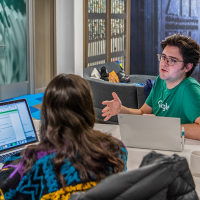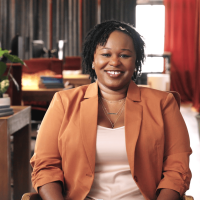Google UX Design Certificate Online
Put your creativity to work with these Google UX design courses that equip you to build and test user-centered solutions and to use Google Analytics to improve usability.
Franklin University has partnered with Coursera Campus to provide cutting-edge certificates to learners seeking to advance. Courses are open to all learners. No application required.
Included in your subscription
Get unlimited access to over 10,000 offerings found on the Coursera website – including guided projects, specializations and professional certificates offered by hundreds of leading universities and companies. You also get access to all 46 professional certificates found in the Franklin Marketplace.
LEARN MOREWhat You Will Learn
- Prepare for a career in the fast-growing field of user experience (UX) design and the learn the foundations of UX design for websites, apps and physical objects
- Learn how to better understand users, ideate concepts, build wireframes, create prototypes, and test and refine designs
- Understand why and how to develop personas and customer journey maps
- Create a professional portfolio of three projects that showcase your UX design skills to prospective employers
About the Google UX Design Professional Certificate
Beginner UX professionals will find the Google UX Design Professional Certificate program packed with professional training courses developed by Google UX experts. This specialized certificate program is designed to put you on the path to a rewarding, fun and competitively paid position in the fast-growing field of user experience design.
Through the seven courses in this certificate program, you'll gain new skills in UX design. You'll go through the entire UX process, including understanding customer pain points, building wireframes, and testing and refining prototypes.
This certificate programs will let you unleash your creativity, too, with hands-on projects that let you practice what you learn. You'll get real-world experience developing empathy maps, personas, customer journeys, value props and more.
You'll also gain experience with in-demand design tools like Figma and Adobe XD. Plus, you'll be putting your completed assignments together to create a professional, attention-getting portfolio that can help you land that first great job in UX design.
Required Google UX Design Certificate Courses

BEGINNER | Computer Science | Self-paced | 14 hours
Foundations of User Experience (UX) Design is the first of a series of seven courses that will equip you with the skills needed to apply to entry-level jobs in user experience design. UX designers focus on the interactions that people have with products like websites, mobile apps, and physical objects. UX designers make those everyday interactions usable, enjoyable, and accessible. The role of an entry-level UX designer might include empathizing with users, defining their pain points, coming up with ideas for design solutions, creating wireframes, prototypes, and mockups, and testing designs to get feedback. Current UX designers and researchers at Google will serve as your instructors, and you will complete hands-on activities that simulate real-world UX design scenarios. Learners who complete the seven courses in this certificate program should be equipped to apply for entry-level jobs as UX designers. No previous experience is necessary. By the end of this course, you will be able to: - Define the field of UX and explain why it’s important for consumers and businesses. - Understand foundational concepts in UX design, such as user-centered design, the design thinking framework, accessibility, and equity-focused design. - Identify the factors that contribute to great user experience design. - Review common job responsibilities of entry-level UX designers and teams that they work with. - Explore job opportunities and career paths within the field of user experience. - Explain why design sprints are an important and useful part of a UX designer’s work. - Describe common UX research methods. - Identify and account for biases in UX research.
BEGINNER | Computer Science | Self-paced | 21 hours
Start the UX Design Process: Empathize, Define, Ideate is the second course in a certificate program that will equip you with the skills needed to apply to entry-level jobs in user experience (UX) design. In this course, you’ll complete the first phases of the design process for a project that you’ll be able to include in your portfolio. You will learn how to empathize with users and understand their pain points, define user needs using problem statements, and come up with lots of ideas for solutions to those user problems. Current UX designers and researchers at Google will serve as your instructors, and you will complete hands-on activities that simulate real-world UX design scenarios. Learners who complete the seven courses in this certificate program should be equipped to apply for entry-level jobs as UX designers. No previous experience is necessary. By the end of this course, you will be able to: - Empathize with users to understand their needs and pain points. - Create empathy maps, personas, user stories, and user journey maps to understand user needs. - Develop problem statements to define user needs. - Generate ideas for possible solutions to user problems. - Conduct competitive audits. - Start designing a mobile app, a new project to include in your professional UX portfolio.
BEGINNER | Computer Science | Self-paced | 11 hours
Build Wireframes and Low-Fidelity Prototypes is the third course in a certificate program that will equip you with the skills you need to apply to entry-level jobs in user experience (UX) design. In this course, you’ll continue to design a mobile app for your professional UX portfolio. You’ll start by creating storyboards and getting familiar with the basics of drawing. Then, you'll create paper wireframes and digital wireframes using the design tool Figma. You’ll also create a paper prototype and a digital low-fidelity prototype in Figma. Current UX designers and researchers at Google will serve as your instructors, and you will complete hands-on activities that simulate real-world UX design scenarios. Learners who complete the seven courses in this certificate program should be equipped to apply for entry-level jobs as UX designers. By the end of this course, you will be able to: - Develop a goal statement. - Create two types of storyboards: big picture and close-up. - Understand the difference between low-fidelity and high-fidelity design. - Apply the basics of drawing. - Apply the principles of information architecture to organize a mobile app. - Create paper wireframes for a mobile app design. - Develop digital wireframes in the design tool Figma. - Build a paper prototype to add interactivity to designs. - Design a low-fidelity prototype in Figma. - Recognize implicit bias and deceptive patterns in design. - Continue to design a mobile app to include in your professional portfolio. To be successful in this course, you should complete the previous two courses in this certificate program, or have an ability to conduct user research to inform the creation of empathy maps, personas, user stories, user journey maps, problem statements, and value propositions. You will also need paper and a pen or pencil.
BEGINNER | Computer Science | Self-paced | 15 hours
Conduct UX Research and Test Early Concepts is the fourth course in a certificate program that will equip you with the skills you need to apply to entry-level jobs in user experience (UX) design. In this course, you will learn how to plan and conduct a usability study to gather feedback about designs. Then, you will modify your low-fidelity designs based on insights from your research. Current UX designers and researchers at Google will serve as your instructors, and you will complete hands-on activities that simulate real-world UX design scenarios. Learners who complete the seven courses in this certificate program should be equipped to apply for entry-level jobs as UX designers. By the end of this course, you will be able to: - Plan a UX research study, including the project background, research goals, research questions, Key Performance Indicators, methodology, participants, and script. - Explain the importance of respecting privacy and user data. - Conduct a moderated and unmoderated usability study. - Take notes during a usability study. - Create affinity diagrams to group and analyze data. - Synthesize observations from research and come up with insights. - Develop persuasive presentation skills to share research insights. - Modify low-fidelity designs based on research insights. - Continue to design a mobile app to include in your professional portfolio. To be successful in this course, you should complete the previous three courses in the certificate program. Or, you need to have an ability to conduct user research to inform the creation of empathy maps, personas, user stories, user journey maps, problem statements, and value propositions; as well as an ability to create wireframes and low-fidelity prototypes on paper and in Figma.
BEGINNER | Computer Science | Self-paced | 20 hours
Create High-Fidelity Designs and Prototypes in Figma is the fifth course in a certificate program that will equip you with the skills you need to apply to entry-level jobs in user experience (UX) design. In this course, you will follow step-by-step tutorials to learn how to create high-fidelity designs, called mockups, in Figma, a popular design tool. Then, you’ll turn those designs into an interactive prototype that works like a finished product. You’ll conduct research to collect feedback about your designs and make improvements. Finally, you’ll learn how to share your designs with development teams and highlight your work in your professional UX portfolio. Current UX designers and researchers at Google will serve as your instructors, and you will complete hands-on activities that simulate real-world UX design scenarios. Learners who complete the seven courses in this certificate program should be equipped to apply for entry-level jobs as UX designers. By the end of this course, you will be able to: - Build mockups and high-fidelity prototypes in Figma. - Define and apply common visual design elements and principles. - Demonstrate how design systems can be used to organize, standardize, and enhance designs. - Understand the role of design critique sessions and feedback while iterating on designs. - Learn how to hand off finished design projects to engineering teams. - Complete mobile app designs to include in a professional UX portfolio. This course is suitable for beginner-level UX designers who have completed the previous four courses of the Google UX Design Certificate. Alternatively, learners who have not completed the previous courses should have a strong understanding of the design process, how to create low-fidelity designs on paper and in Figma, and how to conduct usability studies.
BEGINNER | Computer Science | Self-paced | 16 hours
Build Dynamic User Interfaces (UI) for Websites is the sixth course in a program that will equip you with the skills you need to apply to entry-level jobs in user experience (UX) design. In this course, you will plan a design for a website, create wireframes and prototypes, and test your designs to get feedback. Additionally, you will learn about engaging in design critique sessions and how to give and receive feedback. By the end of this course, you will have a new design project to include in your professional UX portfolio. In addition, you’ll learn how to search for entry-level UX design jobs, create a resume that highlights your skills and accomplishments, and build your professional portfolio website. Current UX designers and researchers at Google will serve as your instructors, and you will complete hands-on activities that simulate real-world UX design scenarios. Learners who complete the seven courses in this certificate program should be equipped to apply for entry-level jobs as UX designers. By the end of this course, you will be able to: - Apply each step of the UX design thinking framework (empathize, define, ideate, prototype, test) to create a responsive website. - Plan information architecture and create sitemaps for website designs. - Apply common layouts for web pages. - Plan and conduct a usability study to gather feedback about designs. - Iterate on designs based on research insights. - Work with design systems. - Add a new design project to your professional UX portfolio. - [Optional] Create or update a UX-focused resume. - [Optional] Learn how to search for and apply to introductory-level jobs in the field of UX. This course is suitable for beginner-level UX designers who have completed the previous five courses of the Google UX Design Certificate. Alternatively, learners need to have a strong foundational understanding of the design process; experience creating wireframes, mockups, and prototypes; and the ability to conduct usability studies. No previous experience with Figma is required.
BEGINNER | Computer Science | Self-paced | 13 hours
Design a User Experience for Social Good and Prepare for Jobs is the seventh and final course in a program that will equip you with the skills you need to become an entry-level UX designer. In this course, you will design a dedicated mobile app and a responsive website focused on social good. You will showcase all that you’ve learned during the certificate program to complete the design process from beginning to end: empathizing with users, defining their pain points, coming up with ideas for design solutions, creating wireframes and prototypes, and testing designs to get feedback. By the end of this course, you will have a new cross-platform design project to include in your professional UX portfolio. This course will also prepare you to land your first job as a UX designer. You’ll learn how to interview for entry-level UX design positions. You’ll get tips from Googlers based on their own interview experiences and their unique perspectives as hiring managers. And, you’ll polish the professional UX portfolio you’ve been building throughout the program so that it’s ready for job applications. Current UX designers and researchers at Google will serve as your instructors, and you will complete hands-on activities that simulate real-world UX design scenarios. Learners who complete the seven courses in this certificate program should be equipped to apply for entry-level jobs as UX designers. By the end of this course, you will be able to: - Apply each step of the UX design process (empathize, define, ideate, prototype, test) to create designs focused on social good. - Identify the differences between dedicated mobile apps and responsive web apps. - Understand progressive enhancement and graceful degradation approaches for designing across devices. - Build wireframes, mockups, and low-fidelity and high-fidelity prototypes. - Add a new design project to your professional UX portfolio. - Create your portfolio of design work for job applications. - Join and participate in online UX communities. - Interview for an entry-level UX design job. - Determine if freelance design work is a good career fit for you. - Learn AI skills from Google experts to help complete UX design tasks. This course is suitable for beginner-level UX designers who have completed the previous six courses of the Google UX Design Certificate.
BEGINNER | Personal Development | Self-paced | 6 hours
All Google Career Certificates now include an optional course, Accelerate Your Job Search with AI. This course was designed by experts at Google and informed by employers, workforce nonprofits, and educational institutions, to help you navigate your path to your next role more efficiently and confidently. No matter where you are on your job search journey—whether you're just starting out, seeking a new challenge, or ready for your next career move—this course is for everyone. You’ll get practical job search strategies and learn how to leverage AI tools (like Gemini and NotebookLM) to uncover your most valuable skills, create a job search plan, manage your applications, and practice for interviews. You’ll walk away with a personalized job search portfolio to help you stand out to employers, including a resume, career identity statement, job search plan tracker, and more. No previous AI experience is required.Complete This Certificate. Get College Credit.
You know that skill-specific courses will open the door to specialized jobs, but did you know that they will also move you closer to a degree at Franklin University?
The University has evaluated hundreds of certifications for industry-recognized proficiencies and awards credit that equates to specific Franklin courses, as well as technical- or elective-credit requirements. See how much time and money you'll save toward your degree by building on prior learning credit.
Browse & Filter

Bolster Your Professional Skills
Take back control or rethink your career by strengthening your skills with a Professional Certificate through Franklin. Learn, hone or master job-related skills with professional development classes that won't break the bank or gobble up your free time. These online courses let you feed your curiosity and develop new skills that have real value in the workplace. Learn at your own pace. Cancel your subscription anytime.

Showcase Your Capabilities
Through Franklin’s partnership with Coursera, Certificate courses let you apply your learnings and build a career portfolio that helps demonstrate your professional capabilities to employers. Whether you're moving into a new field or progressing in your current one, the hands-on projects offer real-world examples that help illustrate your skills and abilities. Project completion is required to earn your Certificate.

Gain a Competitive Advantage
Get noticed by hiring managers and by your network of professional connections when you add a Professional Certificate to your credentials. Many Certificates are step toward full certification while others are the start of a new career journey. At Franklin, your Certificate also may be evaluated for course credit if you decide to enroll in one of our many degree programs.
Frequently Asked Questions
When you enroll in this self-paced certificate program, you decide how quickly you want to complete each of the courses in the specialization. To access the courses, you pay a small monthly cost of $35, so the total cost of your Professional Certificate depends on you. Plus, you can take a break or cancel your subscription anytime.
It takes about 5-6 months to complete the courses and hands-on projects in this program to earn your certificate.
This intermediate-level series is for technology-minded individuals with related experience, such as software development.
Share your certificate with prospective employers and your professional network to demonstrate your competency and qualifications for an entry-level role in UX design.
No. Courses offered through the Marketplace are for all learners. There is no application or admission process.
Please submit your certificate to plc@franklin.edu for review and processing. After your official evaluation has been completed, please review it to ensure that all eligible credits have been applied.
You can submit documentation before or after you apply to Franklin.